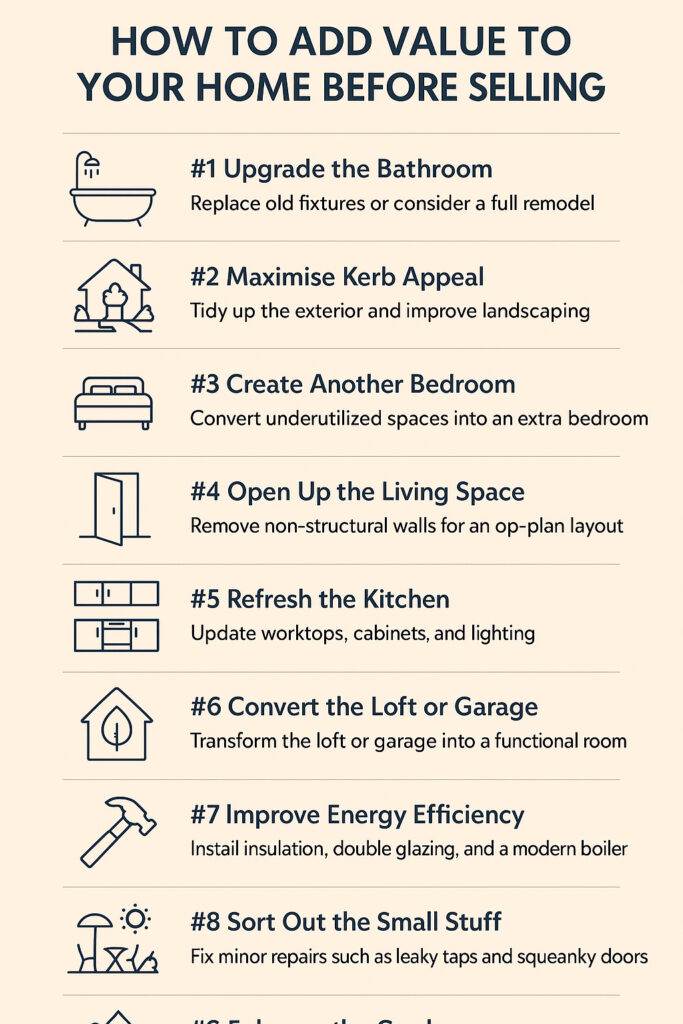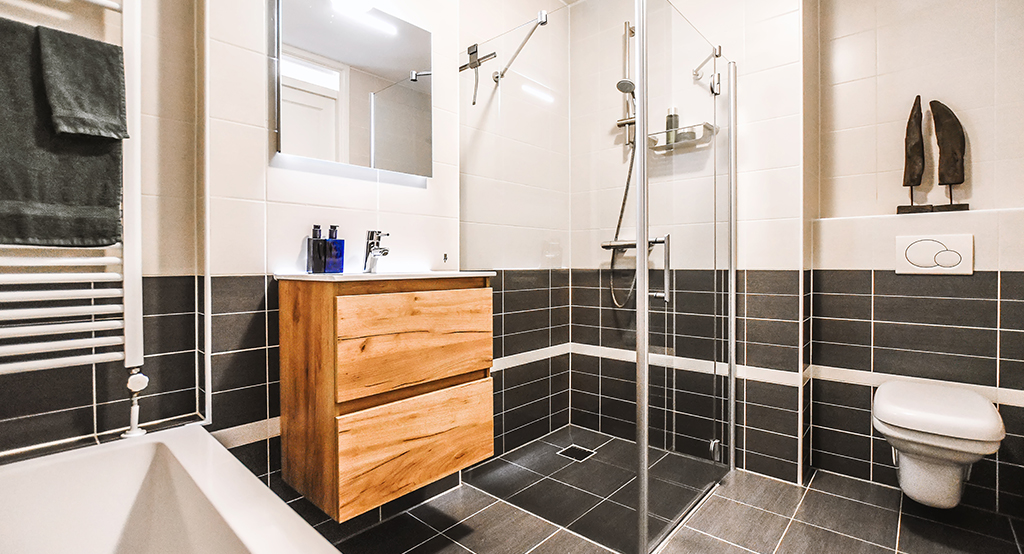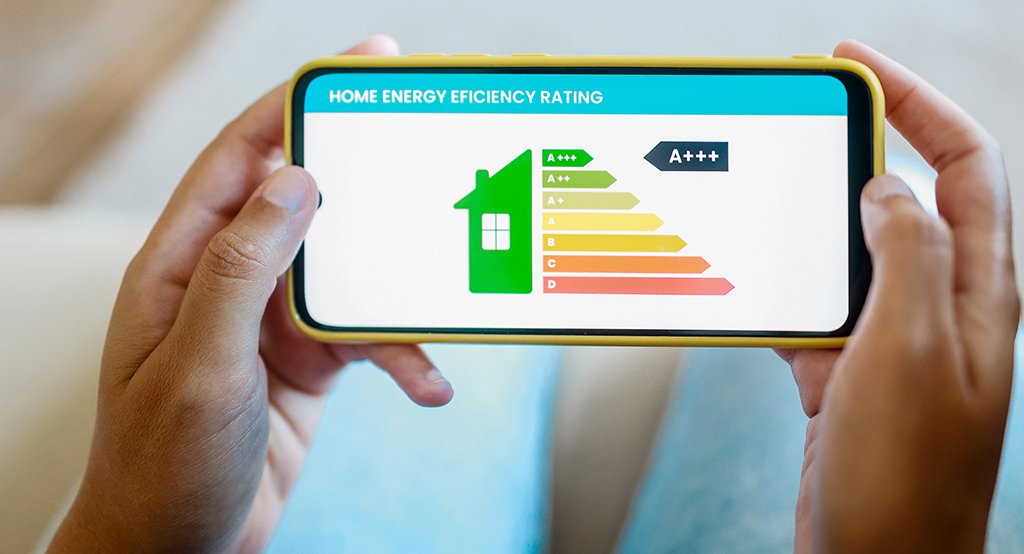Thinking about selling your home? Then let’s talk strategy—because the difference between a decent sale and a brilliant one often comes down to what you do before the For Sale board goes up. The truth is, buyers are savvier than ever, and a fresh coat of paint or a new doormat isn’t always enough. If you want to unlock your home’s full potential and stand out in a competitive market, you need to think smart, spend wisely, and act deliberately.
In this guide, we’ll walk through the top ways to add serious value to your home. We’ll focus on renovations and improvements that have a strong return on investment (ROI)—like upgrading bathrooms, boosting kerb appeal, and even reconfiguring your layout to create additional bedrooms. Whether you’re aiming to maximise profit, speed up the sale, or attract higher-quality offers, this guide has you covered.

1. Understand What Adds Value—and What Doesn’t
Before picking up a paintbrush or calling in the builders, you need to know what actually adds value. Not all upgrades are created equal. Installing a swimming pool might be your dream, but it could put off buyers due to maintenance costs. Similarly, hyper-personalised décor or overly bold choices might not appeal to a wider market.
Instead, focus on features that most buyers actively seek: more bedrooms, modern bathrooms, efficient heating, and functional layouts. These are the things that widen your buyer pool—and with more competition, you’re more likely to get stronger offers. Think of it like this: your goal is to create a home that feels move-in ready, energy-efficient, and easy to live in. That’s where value lies.
Also, be mindful of your location. A £30,000 kitchen upgrade in a neighbourhood with modest house prices might not yield a positive return. Look at nearby sold prices to gauge what ceiling your property might realistically hit after improvements. Stay within context.
2. Upgrade the Bathroom: One of the Best Returns on Investment
Let’s be honest—few things turn off buyers faster than an outdated or grimy bathroom. A modern, fresh, well-lit bathroom can be a major selling point, especially if you create the impression that the space is hygienic and low-maintenance.
You don’t always need a full renovation to make an impact. Sometimes a smart partial refresh—like replacing taps, mirrors, lighting, or tiles—can do wonders. But if your bathroom is seriously dated, a full refit might be worth the investment. A clean, white suite, neutral tiling, good lighting, and underfloor heating can create that luxurious, spa-like feel buyers love.
Another tip? If your home only has one bathroom, adding a second—even a compact downstairs WC—can dramatically increase appeal. It helps with family buyers and makes your home feel much more practical.

3. Maximise Kerb Appeal: First Impressions Count
It might sound like a cliché, but first impressions genuinely matter. A buyer often makes up their mind about a property within seconds of seeing it, and if the front of your house looks neglected, it could cast a shadow over the entire viewing.
You don’t need to spend a fortune to lift your home’s exterior. Start with the basics: clean the windows, repaint the front door, power-wash the driveway, and tidy up the garden. Small touches like new house numbers, planters, or an upgraded light fitting can elevate the entire façade.
If you have more room in the budget, consider redoing the front path or adding off-street parking (where planning allows). In many urban areas, a private driveway can add significant value. Just make sure it’s in keeping with the rest of the neighbourhood.
4. Create Another Bedroom with Clever Layout Changes
Adding an extra bedroom is one of the most powerful ways to boost your home’s value—especially in areas where family-sized properties are in high demand. Estate agents and surveyors alike often place great emphasis on the number of bedrooms when valuing a property, and the jump from two to three, or three to four, can shift your home into a whole new pricing bracket. But the key is doing it without overextending your budget or biting off a full-scale extension project.
One of the most effective strategies is to reconfigure existing space. Large master bedrooms can often be split into two smaller rooms, especially if there’s a window at each end or sufficient floor area to allow for comfortable layouts. Similarly, awkward landings, oversized hallways, or underused box rooms can sometimes be transformed into compact but functional bedrooms. It’s not about cramming in as many rooms as possible—it’s about identifying where square footage is being underutilised and thinking creatively about how it could serve a better purpose.
Loft conversions also offer excellent potential, provided the structure of your home can accommodate them. With proper planning and adherence to Building Regulations—including fire-safe access, insulation, and head height—you can create a bright, stylish top-floor bedroom that feels fully integrated into the home. A well-designed loft bedroom, especially if it includes an ensuite, can dramatically increase your property’s appeal to growing families or remote-working couples looking for extra flexibility.
5. Open Up the Living Space: Light and Flow Sell Homes
Open-plan living continues to dominate buyer wish lists—and for good reason. Removing unnecessary internal walls can completely transform how a property feels, making it brighter, more modern, and better suited to contemporary lifestyles. The trend towards social spaces where cooking, dining, and lounging flow into one another isn’t going away, and homes that offer this kind of layout tend to stand out in estate agent listings and viewings alike.
The first step is identifying where you can safely remove or rework walls to create that sense of openness. If your kitchen and dining room are separate, for instance, knocking through can create a fantastic space for entertaining and daily family life. That said, you’ll need to check whether the wall is load-bearing and, if so, bring in a structural engineer to design the right support solution. A skilled builder will then fit a steel beam or alternative structure to maintain the property’s integrity while opening up the layout.
But creating an open-plan layout isn’t just about taking walls down. To make the space work, you need to think about flow, light, and function. Keep furniture minimal and avoid blocking natural light with bulky items. Use subtle zoning elements like rugs, kitchen islands, or pendant lights to define different areas within the space. Sliding doors, half-partitions, or double-sided shelving units can also help retain some privacy or division while maintaining the open feel. It’s all about creating a layout that feels intentional and flexible—something modern buyers will instantly respond to.
6. Refresh the Kitchen: The Heart of the Home
Kitchens sell houses. It’s that simple. A tired kitchen can drag down an otherwise lovely property, while a fresh, modern one can lift the whole place. But remember—this doesn’t have to mean going top-of-the-range.
Focus on clean lines, good lighting, and efficient use of space. Replacing worktops and cupboard fronts can be more cost-effective than a full replacement. If the layout is good, even painting units and upgrading handles might be enough to create a contemporary look.
Smart features like integrated appliances, LED under-cabinet lighting, or pull-out storage will impress buyers without costing a fortune. And if you’ve got space for a breakfast bar or dining nook, even better. It helps sell the lifestyle.
7. Convert the Loft or Garage
Unused space is wasted value. If you’ve got a garage you don’t use—or a dusty loft filled with old suitcases—these can be goldmines for adding usable square footage. Conversions often cost less per square metre than extensions and usually don’t require planning permission if you stay within certain limits.
A garage can be turned into a home office, guest room, or playroom. A loft can become a main bedroom with an ensuite, making your property significantly more desirable. Always check with your local planning authority and confirm building regulations apply.
And remember, conversions should feel like part of the house—not an afterthought. Think about insulation, heating, and access. A garage that still feels like a garage won’t do you many favours.
8. Improve Energy Efficiency

Energy efficiency has moved from being a ‘nice-to-have’ to a major selling point for many UK buyers. With rising energy costs and growing environmental concerns, homes that promise lower utility bills are immediately more attractive. Buyers want to know they’ll be comfortable without having to constantly adjust the thermostat or worry about excessive heating costs in winter. The good news is that improving efficiency doesn’t always require a full eco-overhaul—it’s often about upgrading what you already have.
The first step is to address the obvious weak points. Loft insulation is one of the cheapest yet most effective upgrades you can make, helping retain heat where it usually escapes most. Similarly, replacing old single-glazed windows with double or triple glazing makes a huge difference, both in temperature control and noise reduction. Adding draught excluders to doors and upgrading to a more modern, condensing boiler with an efficient thermostat system can also quickly improve your home’s Energy Performance Certificate (EPC) rating—something buyers are increasingly scrutinising on listings.
For those willing to invest more, renewable upgrades like solar panels or air source heat pumps can really future-proof your home and make it stand out in a competitive market. These features signal to buyers that the property is not only cost-efficient but also forward-thinking. Underfloor heating—especially in bathrooms and kitchens—adds a touch of luxury while also improving heat distribution. While some of these improvements require upfront capital, they can make your property more desirable, fetch a higher asking price, and help your home sell faster.
9. Sort Out the Small Stuff
It’s amazing how easily little details can shape a buyer’s perception of your entire property. A door that doesn’t shut properly, a cracked plug socket, or a leaky tap may seem minor—but they give the impression that the house hasn’t been maintained. Buyers often assume that if the visible things are neglected, the same may be true for the less obvious areas, like wiring or plumbing. These tiny issues plant seeds of doubt that can grow quickly during a viewing.
That’s why it pays to do a full audit of your home from top to bottom. Go room by room and note anything that feels loose, broken, outdated, or unclean. Light switches should click cleanly, cupboard doors should hang straight, and there shouldn’t be any chipped paint or mouldy sealant. If you’re too used to your surroundings, bring in a friend with a critical eye—they’ll often spot things you’ve become blind to. Most repairs can be done affordably with a bit of elbow grease or a local handyman, but the effect on buyer confidence can be huge.
Presentation is everything. Once the repairs are handled, take it up a notch with a bit of cosmetic polish. A fresh coat of paint in a neutral shade, freshly cleaned or replaced carpet in high-traffic areas, and a good deep-clean of your kitchen and bathroom can go a long way. Even simple staging techniques—like removing clutter, adding fresh flowers, or switching on soft lighting before viewings—help your home look loved and lived-in, not neglected and tired. The goal is to create a sense of ease and readiness, so buyers can imagine moving in without lifting a finger.
10. Enhance the Garden and Outdoor Space
Outdoor space has never been more valuable to buyers. The pandemic fundamentally shifted how people view their homes, and gardens, patios, or balconies are now seen as essential lifestyle extensions rather than afterthoughts. Whether it’s space for the kids to play, an area to entertain friends, or just a peaceful corner to enjoy a morning coffee, buyers are looking for that connection to the outdoors. If your property has outside space—even if it’s small—it’s worth investing in its presentation.
Start by getting the basics right. Clear away any clutter, mow the lawn, and trim back bushes or overgrown trees. Pathways and decking should be power-washed to remove moss and grime. A few potted plants or raised flower beds can quickly inject colour and vibrancy. If your outdoor furniture has seen better days, either replace it or remove it altogether—old, weathered items do more harm than good. A clean, tidy garden, no matter the size, creates an immediate emotional appeal that can stay with the buyer long after the viewing.
If you have the budget and the space, think about adding small features that elevate the space without overcomplicating it. A firepit or pergola, some string lighting, or a compact seating area under a parasol can create a focal point that suggests lifestyle and relaxation. For larger gardens, zoning different areas—like a dining zone, lawn, and a vegetable patch—can make the space feel more versatile and organised. But remember: the key is to strike a balance between charm and manageability. A beautifully presented but low-maintenance garden is the sweet spot that today’s buyers are often seeking.
Final Thoughts: Focus on Buyer Psychology
At the end of the day, adding value isn’t just about materials and money—it’s about mindset. You’re not just selling bricks and mortar; you’re selling the idea of a lifestyle. Every improvement you make should contribute to that narrative: of comfort, practicality, beauty, and ease.
So as you prepare your home for market, keep asking yourself: what would you want if you were buying this property today? When you shift your thinking to match the buyer’s lens, your decisions become clearer—and far more effective.
Invest smartly, plan carefully, and present your home at its best. When it all comes together, you’ll not only attract better offers, but you’ll sell faster and with less stress. And that, in today’s market, is real value. If you are looking for top-quality builders in London to help you add value to your home, then get in touch with us here at Eton Builders for a free consultation.
